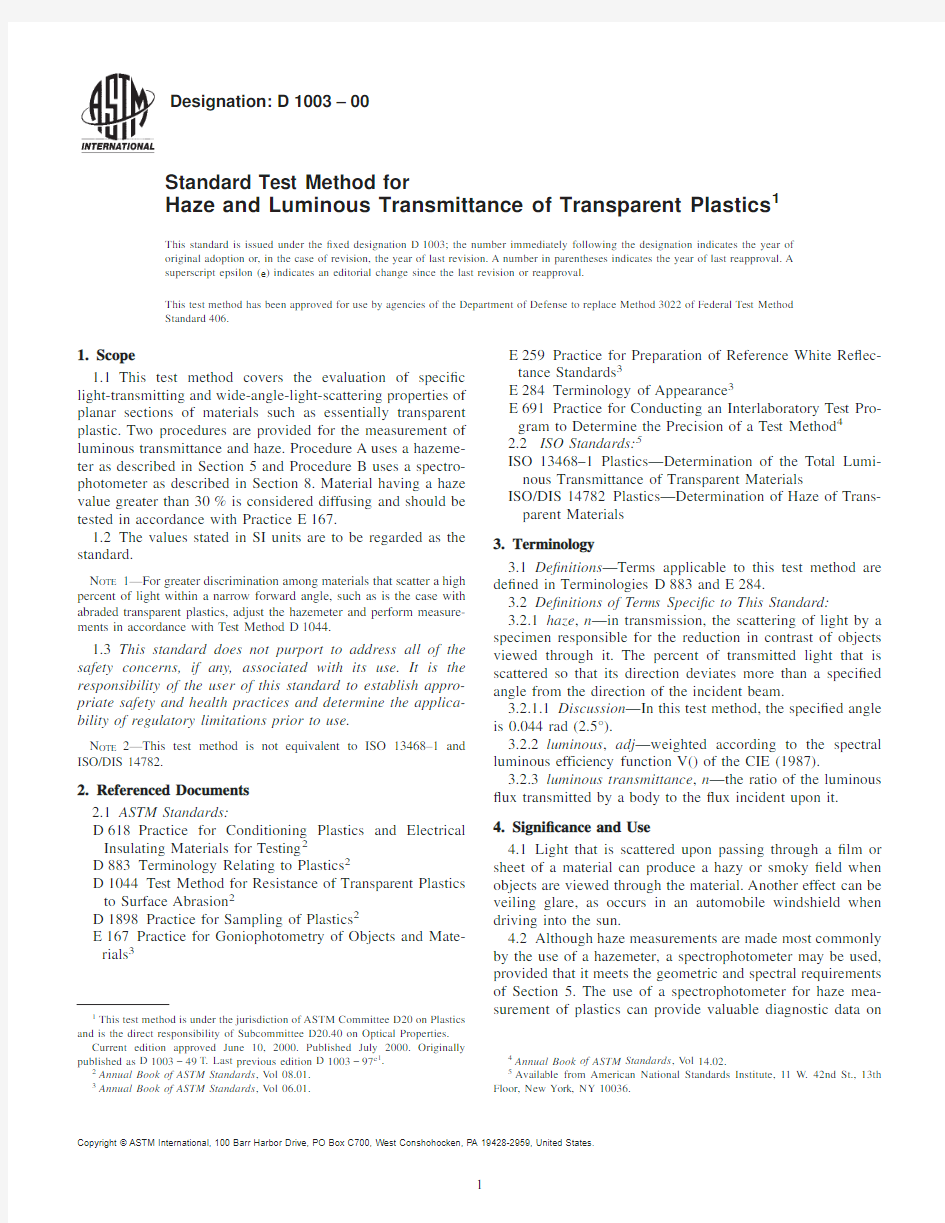
ASTM D1003 雾度,透光率
- 格式:pdf
- 大小:72.59 KB
- 文档页数:6


Designation:D1003–00
Standard Test Method for
Haze and Luminous Transmittance of Transparent Plastics1 This standard is issued under thefixed designation D1003;the number immediately following the designation indicates the year of original adoption or,in the case of revision,the year of last revision.A number in parentheses indicates the year of last reapproval.A superscript epsilon(e)indicates an editorial change since the last revision or reapproval.
This test method has been approved for use by agencies of the Department of Defense to replace Method3022of Federal Test Method Standard406.
1.Scope
1.1This test method covers the evaluation of specific light-transmitting and wide-angle-light-scattering properties of planar sections of materials such as essentially transparent plastic.Two procedures are provided for the measurement of luminous transmittance and haze.Procedure A uses a hazeme-ter as described in Section5and Procedure B uses a spectro-photometer as described in Section8.Material having a haze value greater than30%is considered diffusing and should be tested in accordance with Practice E167.
1.2The values stated in SI units are to be regarded as the standard.
N OTE1—For greater discrimination among materials that scatter a high percent of light within a narrow forward angle,such as is the case with abraded transparent plastics,adjust the hazemeter and perform measure-ments in accordance with Test Method D1044.
1.3This standard does not purport to address all of the safety concerns,if any,associated with its use.It is the responsibility of the user of this standard to establish appro-priate safety and health practices and determine the applica-bility of regulatory limitations prior to use.
N OTE2—This test method is not equivalent to ISO13468–1and ISO/DIS14782.
2.Referenced Documents
2.1ASTM Standards:
D618Practice for Conditioning Plastics and Electrical Insulating Materials for Testing2
D883Terminology Relating to Plastics2
D1044Test Method for Resistance of Transparent Plastics to Surface Abrasion2
D1898Practice for Sampling of Plastics2
E167Practice for Goniophotometry of Objects and Mate-rials3
E259Practice for Preparation of Reference White Reflec-tance Standards3
E284Terminology of Appearance3
E691Practice for Conducting an Interlaboratory Test Pro-gram to Determine the Precision of a Test Method4
2.2ISO Standards:5
ISO13468–1Plastics—Determination of the Total Lumi-nous Transmittance of Transparent Materials
ISO/DIS14782Plastics—Determination of Haze of Trans-parent Materials
3.Terminology
3.1Definitions—Terms applicable to this test method are defined in Terminologies D883and E28
4.
3.2Definitions of Terms Specific to This Standard:
3.2.1haze,n—in transmission,the scattering of light by a specimen responsible for the reduction in contrast of objects viewed through it.The percent of transmitted light that is scattered so that its direction deviates more than a specified angle from the direction of the incident beam.
3.2.1.1Discussion—In this test method,the specified angle is0.044rad(2.5°).
3.2.2luminous,adj—weighted according to the spectral luminous efficiency function V()of the CIE(1987).
3.2.3luminous transmittance,n—the ratio of the luminous flux transmitted by a body to theflux incident upon it.
4.Significance and Use
4.1Light that is scattered upon passing through afilm or sheet of a material can produce a hazy or smokyfield when objects are viewed through the material.Another effect can be veiling glare,as occurs in an automobile windshield when driving into the sun.
4.2Although haze measurements are made most commonly by the use of a hazemeter,a spectrophotometer may be used, provided that it meets the geometric and spectral requirements of Section
5.The use of a spectrophotometer for haze mea-surement of plastics can provide valuable diagnostic data on
1This test method is under the jurisdiction of ASTM Committee D20on Plastics and is the direct responsibility of Subcommittee D20.40on Optical Properties.
Current edition approved June10,2000.Published July2000.Originally
published as D1003–st previous edition D1003–97e1.
2Annual Book of ASTM Standards,V ol08.01.
3Annual Book of ASTM Standards,V ol06.01.
4Annual Book of ASTM Standards,V ol14.02.
5Available from American National Standards Institute,11W.42nd St.,13th Floor,New York,NY10036.
1
Copyright©ASTM International,100Barr Harbor Drive,PO Box C700,West Conshohocken,PA19428-2959,United States.